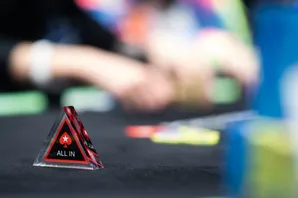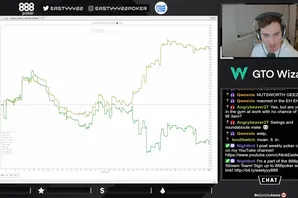
In the first part of this article, we discussed the concept of going “almost all-in” – shoving nearly your entire stack, while leaving a chip or two behind to allow for laddering up if the situation is right. Deciding how many chips to hold back depends on the tournament format and where you are playing. Some tours and governing bodies use the ‘ante first’ format, while others use the ‘big blind first’ format.
The difference between these formats only really comes into play in situations where the player in the big blind has fewer than 2 big blinds left. However, this is an important detail to consider, because in these situations, the chips in the ante are not ‘matched’ by the other players in the same way the chips in the big blind are. This means you can only win from other players the amount you have in the big blind, not the amount you put into the ante.
Let’s break it down with an example to illustrate how the two formats work differently.
The ‘Big Blind First’ Format
The Irish Poker Open, which I played earlier this year, follows TDA rules (Tournament Directors Association). Here’s how the situation works under the ‘big blind first’ format:
The blinds are 500/1K with a 1K big blind ante. You’re in the big blind with 1,100 chips. In this case, you post your 1K big blind first, leaving only 100 chips to go into the ante. This creates a smaller-than-usual ante. Essentially, you are all-in at this point, and if someone else open-raises or limps, you can win from the other players the full 1,000 chips of your big blind and at least 500 chips from the small blind. Plus, if everyone folds, including the small blind, you can win the hand without needing a showdown!
Even though this is a dire situation, you can still double or triple your stack by winning the hand. So, in a ‘big blind first’ tournament, you only need to hold back one full big blind to maximize your potential win from other players.
The ‘Ante First’ Format
In the ‘ante first’ format, the situation changes. Let’s say you’re in the same spot with 1,100 chips. In this format, you would post 1,000 chips into the ante first, leaving only 100 chips to post for the big blind. While all the other players are still playing with a nominal big blind of 1,000 chips, you would only be eligible to collect 100 chips from each player, including the small blind.
So if one player raises and everyone else folds, the most you can win is 100 from them, 100 from the small blind, and your own 1,000 ante back. If you win the hand, you gain 200 chips, but if you lose, you lose all 1,100 chips. This creates a devastatingly negative situation, and you must avoid it at all costs — even if it means shoving any two cards when you’re about to be in the big blind.
In the ‘ante-first’ format, it’s best to hold back two full big blinds instead of one. This allows you to post a full ante and a full big blind, giving you the full leverage of your chipstack. And of course, always be mindful of when the blinds will increase — you might need to hold back more chips than you initially thought by the time your next big blind comes around.
Get Informed Before You Need to Be
The best way to avoid these issues is to ask the floor staff about the tournament format before it becomes a problem. Different cardrooms often have their own house rules, and it’s worth checking whether the tournament follows an ‘ante first’ or ‘big blind first’ format.
For instance, I believe the WSOP uses the ‘big blind first’ format, while the WPT and the TDA use ‘ante first.’ But don’t just take my word for it — always ask the floor before you play. And then, the next time you find yourself going all-in, make sure to consider all your options and make the best poker decision you can.











